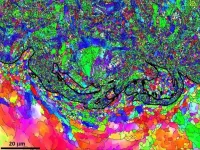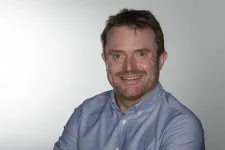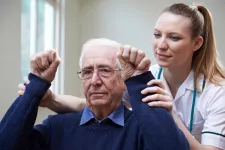(Press-News.org) An international team of researchers has solved a puzzling phenomenon whereby strangely beautiful, vortex-like structures appear between materials deposited onto engineering components used in multiple settings - from space shuttles to household items and everyday transport vehicles.
The discovery may ultimately improve the efficiency of the "Cold Spray" (CS) deposition process from which these structures are formed - a not-insignificant consideration from a financial perspective, or from a functional one given that some of the materials created by CS are pushed to the limit in outer space.
The discovery is featured on the front cover of international journal, Materials & Design.
Cold Spray (CS) and deposition efficiency (DE)
CS enables the formation of coatings, typically metallic, over a substrate material. The technique is highly useful as it does not require engineers to reach the melting temperature of materials to combine the coatings and substrates.
Particles (or metal powder) with a typical diameter about ½ the size of a human hair are propelled at supersonic speeds via an accelerating gas over a substrate surface.
Plastic deformation is key in this process; each tiny particle deforms on impact and triggers a complex bonding process that results in substrate adhesion and in particle-particle adhesion after a first deposition layer is formed.
However, not all the particles adhere. The deposition efficiency (DE) measures the ratio of deposition vs rebound. For example, a DE of 50% means only 50% of the particles incoming flux have adhered to the coating zone.
Inefficiency in the process is a major hurdle given that it is an expensive technique, so increasing efficiency (and driving down costs) is a key research focus.
The vortex-like structures
For quite some time engineers have been observing strange, vortex-like structures at the interface location, between the coatings and the substrates. They are much smaller than the particles, which presented a puzzle: what are they and how do they form?
What's more, these structures don't always appear and, when they do, they show up in a rather random fashion.
Rocco Lupoi, Assistant Professor in Trinity College Dublin's School of Engineering, who is the work leader, teamed up with close colleagues and experts in China, the US, Czech Republic and with the Advanced Microscopy Laboratory (AML) in TCD to solve the puzzle.
He said:
"We discovered that the interface vortices only form when the CS process is not working very well, and thus has low DE values. Under low deposition efficiency, most of the sprayed particles rebound after their impact. By causing severe plastic deformation of the first-layer coating and substrate this results in a 'hammer effect', which leads to the formation of the vortices.
"This formation also depends on the coating-substrate material combination where the coating materials must have sufficiently high density to generate enough energy for creating large plastic deformation of the first-layer coating and substrate. Additionally, the substrate materials cannot be too hard so that plastic deformation can be induced onto it.
"Potentially, our discovery may help to improve the adhesion between the cold-sprayed coatings and the substrates. To benefit from this, while maintaining reasonable process economy, one could first create an intermixing interface through low-DE deposition, followed by production of the coating using optimised processing parameters."
Shuo Yin, Assistant Professor in Trinity's School of Engineering, who is the first author in the paper and the lead scientist in this work added:
"This was a great multi-disciplinary effort and has shed some light into a phenomenon that had puzzled the community for some time. The CS process does not function via the melting of the feedstock material, which is advantageous because it means there are limited to no-heat-affected zones, microstructural changes, or distortions to worry about on the end-products.
"Despite progress, CS remains a process under development, so part of our work is focused on improving the deposition performance, coating quality and substrate-coating bond strength. We hope this discovery opens the door to further improvements on that front."
INFORMATION:
Why do genes need to be silenced? The "genes" in question are in fact transposons, selfish genetic elements that seek to self-multiply at the host's expense and that need to be controlled. Julius Brennecke's group at IMBA focuses on lifting the mysteries of a specific type of transposon silencing, namely the piRNA pathway in animal gonads. Understanding this ancient silencing system promises to reveal general mechanistic principles of gene expression and chromatin biology.
Gene silencing: either before they "speak", or right as they attempt to
Heterochromatin, a tightly packed form of DNA, plays an essential role in transposon ...
Many steep valleys in the European Alps show the relicts of large rockslides, during which several hundreds of million cubic metres of rocks get instable, collapse and impact everything on their path. "For most of these, we still do not know how they are caused, because these rockslides occurred long before the start of written history in the region about 1000 years ago," says Patrick Oswald, PhD student at the Department of Geology of the University of Innsbruck and lead author of the study. "Curiously, many of these ancient rockslides occurred together in clusters, meaning they are found in small regions and have a rather comparable age". This enigmatic pattern has puzzled researchers over the last decades and fuelled some intense debates. Some experts ...
"Thin films are solid state substances that can be only several atomic layers thick. Usually, their properties are considerably different from the properties of the original substances on the macroscale. The areas of their application keep expanding and include nanoelectronics, optoelectronics, spintronics, electro-, and photocatalysis, as well as such important fields of economics as space technologies and instrument building. Micromodule devices for space crafts and medical technologies are also promising areas in which thin films can be used," said Vyacheslav Fominski, a project supervisor representing MEPhI.
To reduce friction and solve many ...
Cataracts are the most common eye ailment in humans. However, the exact processes leading to this condition are not fully understood. A team of researchers headed by the Technical University of Munich (TUM) has now discovered that the composition of the protein solution plays a decisive role. Their conclusions are contrary to prevailing opinion in the field.
The cells in the lens consist of a highly concentrated protein solution that is normally clear. "When the balance of the proteins in the lens is destroyed, they clump together and the lens becomes cloudy," says Prof. Johannes Buchner of the Chair of Biotechnology at TUM. This results in the condition known as cataracts.
The clouding can have different causes. Because the proteins in the lens are formed ...
The 'sloshing' of a quantum fluid comprised of light and matter reveals superfluid properties.
An Australian-led team of physicists have successfully created sloshing quantum liquids in a 'bucket' formed by containment lasers.
"These quantum fluids are expected to be as wavy as the oceans, but catching clear pictures of the waves is an experimental challenge," says lead author Dr Eliezer Estrecho.
Led by the Australian National University (ANU), the team serendipitously observed the wavy motion of the quantum fluid in an optically-controlled bucket, gaining new insights of the intriguing superfluid properties of this peculiar, hybrid light-matter system.
Superfluidity ...
The processes in living beings follow a finely orchestrated choreography down to the molecular level. Rhythmic processes are found everywhere in biology, for example, the 24-hour circadian cycle, a kind of "internal clock", plays an important role in regulating many processes in living cells, including metabolism and cell division mechanisms.
Scientists from Saarbrücken and Kaiserslautern have now taken a closer look at a similar cycle, the somewhat shorter ultradian cycle of baker's yeast. Under the leadership of Bruce Morgan, Professor of Biochemistry at ...
Combining healthy lifestyle interventions reduces heart disease through beneficial effects on different lipoproteins and associated cholesterols, according to a study published February 9 in eLife.
Having a healthy lifestyle has long been associated with a lower risk of developing heart disease. The new study provides more detailed information on how healthy lifestyles improve cholesterol, and suggests that combining cholesterol-lowering medications and lifestyle interventions may yield the greatest benefits to heart health.
Cholesterol-lowering ...
The fact that cells are motile and come into contact with each other is one of biology's fundamental principles. During embryonic development, cells must communicate with their neighbors in order to find their proper place in the differentiating organism. Wound healing is another process in which direct intercellular interactions are essential. In this context, motility enables cells to migrate to the location of the lesion and regenerate lost structures. Cancer cells also make use of this property to leave their site of origin in the primary tumor, which allows them to initiate the formation of metastatic tumors in other tissues.
"In recent years, biologists ...
An international study has shown, for the first time, that the capacity of the human brain to recover and rewire itself peaks around two weeks after a stroke and diminishes over time.
The finding, published today in the Neurorehabilitation and Neural Repair journal, is the result of a study in London and Adelaide that followed the recovery of 60 stroke patients up to one year after their stroke.
Lead author Dr Brenton Hordacre, from the University of South Australia, says the multi-site study showed conclusive evidence that the brain only has a small window of opportunity to more easily repair itself after stroke.
"Earlier animal studies suggested ...
Icebergs are melting faster than current models describe, according to a new study by mathematicians at the University of Sydney. The researchers have proposed a new model to more accurately represent the melt speed of icebergs into oceans.
Their results, published in Physical Review Fluids, have implications for oceanographers and climate scientists.
Lead author and PhD student Eric Hester said: "While icebergs are only one part of the global climate system, our improved model provides us with a dial that we can tune to better capture the reality of Earth's changing climate."
Current models, which are incorporated into the methodology used by the Intergovernmental Panel on Climate Change, ...




